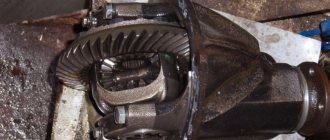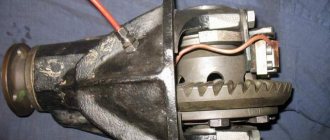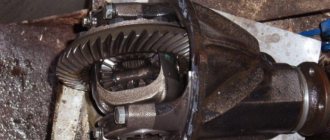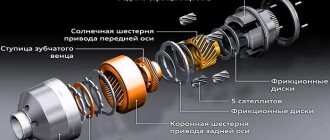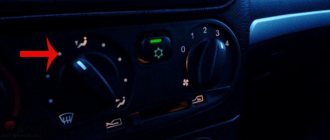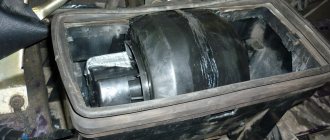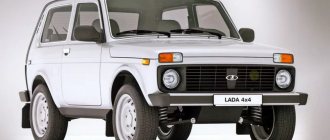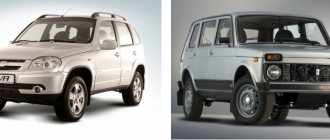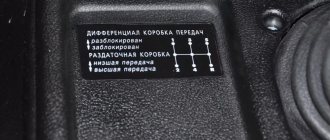Differential lock in Shevik - I didn’t know, but in vain
Hello everyone, I'm back in touch and today I have an important topic for you about blocking.
I admit, I have never drilled in severe off-road conditions, and therefore have never even used a lock. And in general, until recently, I had a vague idea of what other positions there are in the transfer case besides low gear and why are they needed. But today I saw with my own eyes how the Chevy Niva was slipping on the ice and only 1 wheel was spinning - the one that was slipping. All the other wheels just stood there, not spinning. For me, to be honest, it was akin to a revelation, I would never have thought that this could happen, I personally thought that all the wheels of the Niva and Shevik always spin. A naive young man, to be sure)) But I’m still just starting to master my Chevy Niva and am learning everything I didn’t know.
And then the driver engages the standard lock and, lo and behold, the front axle, one front wheel also began to spin and the car drove off the ice hill without any problems.
Just like that, I thought, and when I came home, I sat down to study the materiel, which I will share with you.
Transfer case - lowering and locking
If you don’t know how to use the transfer case, where everything is turned on, then here you go, clearly with a photo. Immediately learn to turn on the lowering and locking. And not thoughtlessly, but at the right moments.
So, by default, on Niva and Shevik, in the transfer case you can turn on not only a low gear, but also add a center differential lock to it. In the example above, everything became clear how this locking works - if at least one wheel is stuck, then without locking the maximum is given to it - all the torque goes to this one wheel. All 100 percent. By turning on the lock, we transmit torque to another axle (another axle - front or rear). So thanks to it, the car sometimes very often copes not only with ice, but also with off-road conditions - liquid mud is akin to ice, as soon as the wheel starts to slip - all the momentum goes to it and the car stops. We turn on the lock, the wheels of the other axle begin to spin and the car starts to move.
However, what to do when other wheels begin to slip? Then screw it, you won’t go anywhere. This is called diagonal hanging, and in this case only inter-wheel locking will help. I think the meaning is clear - the torque is already transmitted from the right wheel that has stalled to the left one and vice versa. So to speak, the car becomes even more improved.
Inter-wheel locking is most often done by installing self-locking differentials, which can be installed in the front and rear axles, or in two at once if you are a fan of off-road conquest. Their short name, which everyone knows, is self-blocks. There are automatic and forced. Prinudilovo is, of course, cooler, but probably more complicated and more expensive.
What kind of self-blocks are these?
I googled and found out that most often they are installed by two manufacturers - DAK and Val Racing, Daki - most often installed on UAZ of all types, and "Val Racing" can be installed on Niva and Niva Chevrolet - the option is simply ideal.
The principle of operation is exactly the same as that of the center lock, only here the moment is transferred between the wheels - that is, the right wheel slips - the automatic lock is activated (DAK and Racing - they are automatic) and the moment is transferred to the standing left wheel. Inter-wheel locks help a lot in getting out of ruts when, as a rule, 1 wheel out of two on the same axle slips.
Everything looks simply gorgeous and I immediately wanted to install Val Racing. However, having learned the price - 10,000 rubles per set (2 pieces), plus the installation of 4-5 thousand, in total the installation of such self-blocks on one bridge already amounts to 15k. I’ll save up, it’s a mega useful thing in my opinion.
Most often they install a block on the rear axle, however, as the pros say, installing self-blocks on the front axle increases cross-country ability more noticeably than on the rear axle. However, here the controllability deteriorates and other other troubles up to an increased load on the auxiliary suspension elements. Nothing passes without a trace))
So if you haven’t used a lock on your Chevy Niva before, be sure to try it when you find yourself in liquid mud. It is strictly forbidden to use the center wheel on a regular highway/asphalt, only off-road.
Well, if you at least sometimes go off-road for fishing, hunting and picnics, then install normal mud tires. Do I often see Sheviks on road tires in the city? For what? Why put regular tires on a Chevy Niva? Chevy is designed to drive in rural areas, but driving such a car purely around the city is nonsense. It consumes a lot of gas in the urban cycle. Therefore, if you are already interested in blocking, then the rubber must be toothy. Of the imported ones, I recommend, of course, Goodrich (if you have a lot of money), Kumho or Hankuk (if you have less money), and if you’re short on money, then only Cordiant Offroad or the Kirov K-139.
Chevrolet Niva 2006, 80 l. With. - spare parts
In contrast to the suspension, it has a very weak transmission and steering system. Categorically not designed for jerking and shock loads. This increases the load on the transfer case bearings. There is a diagram on the shift lever. To engage a downshift, you need to move the lever to the right, up. To lock the differential, pull it all the way to the left.
There are also Latin letters on the lever. So, L is a low gear, N is neutral, and H is high. Now let's find out how to use all this so that we don't have to repair the mechanism and change the transfer case bearings.
So, if you have to overcome a ford or a puddle, you should stop completely and turn on a lower set of steps. Even at 5 kilometers per hour you will have problems with the transfer case. But you can lock the differential even while driving. This won't bring any surprises.
What is it for?
Unless fuel consumption increases due to the constantly working two axles and axle shafts. In what cases is it necessary to engage a downshift on a Chevrolet Niva? Please note that it should only be enabled when absolutely necessary. Otherwise, the load on the teeth and shafts increases. Forced unlocking Sometimes it happens that the lock gets stuck - it cannot be turned off even when the car is completely stopped.
The situation is quite common for the Chevrolet Niva. To do this, engage reverse gear, accelerate a little and turn off the differential lock while driving.
But if a similar lamp continues to light on your instrument panel, as in the photo below, the lock has not been turned off.
What to do in such a situation? It is necessary to turn on the first speed and try to turn off the unit again. Moving back and forth will solve the problem of a stuck differential. In general, it is recommended to turn on the center lock only in serious off-road conditions.
At the intersection of dirt roads and sand dunes, a downshift is sufficient. Overcoming a deep puddle Often a dispute arises between motorists about how best to cross a ford with a transfer case. You may ask - how long does it take to turn on the blocking and then turn it off? There is another nuance here - very often, many owners of the Chevrolet Niva have a problem with the blocking - it does not turn off.
How to use the transfer case on a Chevrolet Niva? Video review
It just jams and that’s it, you have to drive on the highway with the blockage. This, you understand, is very harmful for the machine and in such cases you must turn it off.
There are several options - turn on reverse, accelerate a little and try to dislodge the lock while driving. You need to do this at speed; it works quite often. Moreover, you can accelerate forward and also try to turn off the lock. I also got stuck once, but even then I didn’t notice it right away and it’s not a problem.
In bright sunny weather it is sometimes difficult to see. Well, about turning off the center wheel - I managed to turn it off just when reversing.
Needless to say, now I turn it on only in the most dire cases. In the rest of the others, lower gears are quite enough for me. Just today I went to the lake to check if the ice had melted.
Do-it-yourself differential lock on Niva Chevrolet
The Chevrolet Niva is one of the few Russian-made SUVs that, in addition to excellent cross-country ability, can also boast a relatively modern design. Therefore, it still enjoys well-deserved popularity in the market.
The Chevrolet Niva owes its good off-road characteristics to its predecessors - the VAZ2121, namely permanent all-wheel drive, with the possibility of forced differential locking. But before setting up the transfer case and using the gearshift levers correctly, you must first understand how this mechanism works and what happens during its operation.
The transmission of this type of car consists of several main components: cardan, gearbox, transfer case and axles. The main component in the bridge structure is the differential. If it were not there, the wheels would rotate at the same speed, which would lead to wheel slipping and excessive load on the axle. The presence of a differential allows you to avoid destruction of the axle due to the fact that when turning, torque is transmitted to one of the wheels.
The design itself provides for the transmission of torque to the wheel, which experiences less traction with the surface. Therefore, for example, a wheel that stands on ice or sand will spin faster than one that stands on asphalt.
The Niva design provides for the presence of three differentials. This is due to the presence of permanent all-wheel drive in the car. If the same force were transmitted to all wheels, then the car could only move in a straight line. But when turning, the forces between the wheels are distributed unevenly. Accordingly, two bridges connected to each other will invariably experience increased loads that can destroy the structure. There are some SUV models that do not have a center differential installed, but they use other technical solutions, such as clutches or all-wheel drive is not permanent.
Off-road vehicles GAZ
In this category, it is worth noting the unusual model under the symbol 2330, known as the “Tiger”. The car is an armored military SUV, which is designed to transport personnel and cargo. The vehicle is equipped with a universal platform designed to accommodate various types of weapons and special equipment. During serial production, about two dozen variations of this car were created.
The Tiger all-terrain vehicle has a number of features, namely:
- The model of the “6-A” series has eliminated all the shortcomings of its predecessors. In particular, the protection class has been increased.
- An additional compartment with a closed awning is equipped.
- The equipment still has four doors and all the advantages of the prototype.
In terms of civilian characteristics, the SUV in question is a twin “pickup” with a reliable high-power unit and excellent cross-country ability. In terms of safety, the vehicle received protection from fire from a distance of 5-10 meters (from a 7.62 mm rifle cartridge and incendiary analogues of the M-948, which have an armor-piercing core).
The all-terrain GAZ vehicle in question can accommodate up to nine personnel and is initially aimed at transporting commanders in combat zones. According to Russian standards, the armor protection category of an SUV is the highest category “6-A”.
In the shortened version, the crew was reduced to four people, but there was a block of additional shock absorbers, comfortable seats with footrests and enhanced protection against mine activation. This made it possible to increase the protection parameter to six kilograms under the wheels and 3 kg. in the bottom area.
What is forced differential locking?
It is only necessary in cases where, for example, only one of the 4 wheels will rotate. For example, when hanging horizontally, one wheel will be raised and maximum torque will be transmitted to it. In this case, all-wheel drive will be automatically disabled. Therefore, a forced differential lock is installed on the Niva. But it should only be used in off-road conditions. You can turn it on by moving the small lever forward.
The changes introduced by the American concern GM to the transfer case turned out to be quite minor. But at the same time they radically changed its structure. Compared to the old Niva, the need for an additional lever has disappeared and there are only two of them left. The modified location of the transfer case supports made it possible to reduce the vibration load on the body, thereby significantly reducing the noise level from the transmission.
Can I avoid getting my license suspended for driving backwards in 2021?
What if the violation was recorded by a camera?
Maximum fine.
Road photo and video cameras have not yet learned to identify the driver. They only determine the license plate number of the vehicle. Next, a violation is registered at the data center, and the owner of the car receives a “letter of happiness” with a fine of 5,000 rubles.
In other words, if you entered a one-way street under a “brick” sign or turned around and were driving in the opposite direction, and the camera recorded it, expect a fine. It doesn’t matter whether the first fine is for driving “against the grain” or the second – all the same, the cameras will only show a fine. There is no deprivation of rights!
What if I violated it for the first time?
Most likely you will get off with a fine.
The first violation is “harmless” for the traffic police and the courts. In the sense that you will not be classified as a persistent traffic violator. This means that one of the main aggravating circumstances is excluded - the repetition of the offense. Typically, in such cases, both traffic police chiefs and magistrates impose a fine of 5,000 rubles for driving against traffic on a one-way road.
Advice! To accurately tip the scales in your favor, it is better to admit guilt, complain about your own indiscretion and promise to pay the fine as soon as possible. And, if you believe the statistics of court decisions in 2022, this works great, provided that you got caught the first time.
Urgent necessity
This is rare, but it is a reason to avoid responsibility.
What could this mean in the context of driving against traffic on a one-way road:
- An attempt to avoid danger, for example, a car ahead caught fire, so as not to be harmed by an explosion, you turned around and drove back, and the violation was recorded by a camera;
- Help for victims, for example - they were transporting a seriously wounded person, and the shortest way to the hospital was in the opposite direction along the road (and again a fine from the camera or the threat of deprivation of rights).
Situations may be different. But in any case, you must prove that you acted forcedly due to an emergency situation. Download the recording from the DVR, print out news reports from newspapers, find witnesses - this will support your position and help you avoid sanctions under Part 3 of Art. 12.16 Code of Administrative Offenses of the Russian Federation.
Reversing on a one-way road
Whether they will be punished or not depends on the specific maneuver and the signs nearby.
Driving backwards on a one-way road is permitted:
- And secondly, clarifications on this issue were given by the Supreme Court in Resolution of the Plenum No. 20
Paragraph 5 of clause 16 of PPVS No. 20 states that:
The exception is moving backwards under a “brick”. In other cases, you cannot be held accountable under Part 3 of Art. 12.16 Code of Administrative Offenses of the Russian Federation. But if this happens, you should collect evidence and appeal the decision. And you need to refer, among other things, to Resolution of the Plenum of the Supreme Council No. 20.
If there was no "Brick" sign?
This means you haven’t violated anything, and you won’t face imprisonment or a fine.
What do you mean there was no sign? For example, a “No Entry” sign was blown away by a strong wind, covered with snow, or turned in the other direction. In a word, there is no “brick” - there is no zone of its action. This means that an administrative offense on your part is not formed.
But not everything is as simple as it seems. Traffic police inspectors may catch you further than the 3.1 “No Entry” sign should have been. Consequently, your arguments in the spirit of “There was no sign, so I passed” will seem unconvincing. In this case, you need to record the absence or reversal of the “Brick” in the photo and video. Even if a report is drawn up against you, in the future this evidence will help you challenge the violation at the traffic police department or in court.
By the way, if sign 3.1 is really missing in its place, the traffic police officer must draw up a report addressed to the Directorate for Traffic Management. Based on this, workers will install the sign in the right place.
Differential lock
Forced blocking not only complicates the design but also automatically makes it more expensive and less reliable. But if you install a differential lock yourself, this is usually caused by the desire to replace the standard differentials with a forced locking mechanism. This can negatively affect the operation of the transfer case, so it is necessary to select those parts that will be compatible specifically with the Chevrolet Niva.
At the moment, among the solutions presented on the market, the most popular are those made on the basis of:
- pneumatics
- electronic control
- self-locking
Each of them has both advantages and some disadvantages in operation.
Turning on all-wheel drive.
The use of blocking will be justified in the following cases:
- If there is a possibility of wheel slipping, in areas with poor surface conditions,
- If there is a lack of engine thrust at high speeds,
- When driving on roads with loose surfaces, snow, ice.
You should also take into account some features of the Chevrolet Niva, namely, the helplessness of the transmission when hanging diagonally. In this mode, the wheels begin to spin, so if necessary, you need to dig under the wheel or make an embankment under the raised axle.
Many car enthusiasts like SUVs due to their high maneuverability in difficult terrain. Among domestic cars, a striking example is the Chevrolet Niva brand. And in order for the car to be able to overcome hard-to-reach obstacles, you cannot do without differential locking on the Niva. Regardless of the brand of SUV, including the aforementioned Niva, all cars have one characteristic feature, which is the presence of all-wheel drive and differential. More detailed information is provided below.
Self-locking system
Can be configured to the required switching threshold. This can be either a slight slip or uneven distribution of torque among the wheels. Such a connection is not rigid, and therefore does not place unnecessary load on the interaxial connection.
When installing a forced locking system on a Chevrolet Niva, you should remember that a constantly turned on system can put unnecessary stress on the transmission, so you should turn it on only when overcoming difficult sections of the road.
Forced blocking on Niva and Chevrolet Niva: advantages over self-blocking
The reason for the popularity of the Niva and Chevy Niva is that they are equally comfortable to drive both on public roads and off-roads of varying difficulty.
However, different operating conditions also place different demands on a vehicle's transmission.
In off-road conditions, it may be necessary to transmit torque to both wheels, which is why the differential lock is used.
But as soon as you leave the dirt on the usual asphalt, the differential must be unlocked again.
This is where forced blocking of Niva comes to the rescue.
The main advantage of this type of locking over the so-called self-locking differentials (self-locking differentials) on the Niva is that the process of controlling the locking mechanism becomes completely controllable.
You simply press the differential lock on/off button when the need arises, thereby fully controlling the operation of the locking mechanism.
The locking mechanism is driven by a pneumatic drive, the operating diagram of which we described in the review of forced locking for UAZ Spicer Bridge vehicles:
Useful tips
To use the lock installed on the Niva effectively, use the following recommendations from experts:
- When driving on good quality road surfaces, install the front transfer handle at the front and the rear at the rear.
- The front handle is moved back if the road becomes slippery. Once the slippery area has been passed, switch the levers to normal mode.
- If the Niva is stopped, the lock may not engage when the clutch is depressed. This occurs due to the alignment of the teeth with the gear teeth. What should you do in this case? Moving as if on a turn, engage the lock. The differential will turn and the gear teeth will come closer to the teeth. If turning off is difficult, do it while the vehicle is moving, maintaining a minimum speed and squeezing the clutch.
Advantages of forced blocking from IZH-TECHNO
What are the advantages of our forced blocking over existing analogues?
Forced locking kit
- The first, important point is the ease of installation and the availability of all the necessary components for installation . The differential assembly with our lock is installed in its standard place in the axle gearbox. You do not need to somehow “finish” the gearbox or purchase additional spare parts such as claw couplings or original axle shafts. Our locking is compatible with original axle shafts. All you need to install it is a standard set of plumbing tools. No “exercises” with a welding machine and grinder.
- Our locking system consists entirely of original components produced by IZH-TECHNO. Therefore, we guarantee the high quality of its individual components and locking elements; In turn, the high quality of components is a guarantee that you will not need any spare parts throughout the entire service life of the product, because there is simply nothing to break in it.
- We paid special attention to such a parameter as the strength of the satellite group . This is no coincidence: after all, it is she who transmits torque to both wheels of the axle and experiences the highest loads. The strength of the satellite group is confirmed by a series of tests carried out both in laboratory conditions and in real off-road conditions.
The lock has four satellites instead of the standard two
- The blocking has four satellites , instead of the standard two. This design allows for even distribution of torque and is more reliable than stock. We paid special attention to the parameters of the satellites themselves, increasing the thickness and height of the splines (see photo below):
On the left is a stock satellite, on the right is a satellite produced by IZH-TECHNO
- Protection of the pneumatic drive of forced blocking. The pneumatic drive is hidden inside the axle housing and is protected from mechanical influences; it cannot be broken or damaged.
- The differential housing is manufactured with high precision and strict tolerances , which ensures the absence of vibrations and noise in the axles when driving on the highway.
Niva differential housing cover
- Speed of blocking . By increasing the number of teeth involved in the differential locking, we achieved quick response of the locking mechanism. You don't have to wait for the wheel to rotate to 120 degrees for the system to finally work. In our case, 9 degrees will be enough.
- Versatility . The lock is suitable for all modifications and variants of Niva and Chevrolet Niva cars; it can be installed in both the rear and front axles, in both steel and aluminum front axle gearboxes. Locking options for 22 and 24 splines are available.
Read more about the features of forced blocking on Niva and Chevrolet Niva in the description on our website.
Japan
The Land of the Rising Sun, which has been a trendsetter in off-road fashion for at least the last 50 years. Therefore, Nissan and Toyota are vying for the title of best car, with the former having two brands, and the latter having at least three cars vying for this title.
Toyota 4Runner
The first model was released in 1985. Since then, the production of this SUV has not stopped. In 2009, the 5th generation was introduced, and in 2014 it was restyled. In 2000, more than 100,000 off-road vehicles bearing the Runner name were sold.
The Limited version features a special X-REAS suspension that, combined with unique Bilstein shock absorbers, automatically adjusts when installed on 20-inch aluminum wheels. The TRD Pro Series version features all-wheel drive, a locking rear differential, and an intelligent adaptation system for various road surfaces. The most vulnerable places are protected by special plates.
To overcome severe off-road conditions, the KDSS (Kinetic Dynamic Suspension System) system is provided, which turns off the stabilizer and increases the movement of the axles. If necessary, the car can tow another car weighing more than two tons.
In terms of comfort, the buyer is offered a leather interior or seats covered with water-repellent material; it is possible to install a third row. There is 2-zone climate control, an Entune Audio Plus audio system with 15 speakers, Connected Navigation, and a transparent sunroof.
Toyota Hilux
In the rating of off-road vehicles for cross-country ability, this brand enjoys well-deserved authority among drivers and experts. It has been produced in Japan since 1968. For the North American market it was adapted and given a new name - Toyota Tacoma.
In the fall of 2015, the eighth generation was introduced with a large selection of power units. The 4.0-liter V-shaped petrol six is considered the most powerful unit of all seven power plant options. It is capable of producing 278 hp.
Constantly working to improve off-road performance, engineers do not forget about the comfort of the car. Inside there is a high-quality leather interior, the ability to start the engine without a key is provided, and an automatic air conditioner maintains the microclimate in the cabin. A wide range of functions are controlled using a 4.2-inch touch screen.
Nissan Xterra
A pickup truck manufactured in Tennessee cannot fail to be included in the off-road rating of off-road vehicles, the list of which will be expanded further. The official presentation of this car took place relatively recently - in 2005. But in fact, it is known much earlier under the name Nissan Navara, which debuted in 1986.
This car is directly related to sports, because it got its name after the brand acted as the main sponsor of triathlon competitions. The events took place in an area called Xterra.
This simple and reliable model is designed for use on roads with difficult terrain, the ground clearance reaches 23 cm. Initially, minimal attention was paid to comfort. But the latest trim levels include power accessories, cruise control, a Rockford Fosgate audio system, a multifunction steering wheel, Bluetooth communication, heated seats and much more. The SUV was built on a cargo platform, so it cannot always drive through narrow streets.
Nissan Frontier PRO-4X
In 2016, the mid-size pickup truck received the honorary title of winner in the “Best Compact Pickup Truck” category according to the Autopacific brand.
Along with a manual transmission, all Nissan Frontier cars are equipped with an automatic transmission. This approach allows women to operate this car on an equal basis with men. For better cross-country ability, a rear differential locking system is installed. Roomy, with high ground clearance, it can take a large amount of cargo and allows passengers to sit comfortably. If you need to spend the night in an open area, the body is specially designed to accommodate an overnight tent. Under the hood there is a 4-liter V-6 with a capacity of 300 hp.
The SUV is exported to Australia, New Zealand, Argentina and Mexico. He is a member of the Ultimate Factory, where he often takes honorable prizes.
Cross-wheel differential and its connection with Chevrolet Niva axles
Experts say that the cross-axle differential is the basis of each drive axle of a given vehicle. This is due to the fact that in the absence of a Niva differential device, Chevrolet could only drive in a straight line. The explanation is as follows: when making a turning movement, wheels connected by one axle travel different distances. With a rigid axial fastening, one of them will definitely begin to slip. In addition, the load on it will be prohibitive.
Experts have developed a device that helps to avoid troubles with wheels while the entire vehicle is turning. It's called a cross-axle differential. A differential device is installed between the wheels connected by one axle. The main function of the differential is to distribute possible forces to one wheel.
On the Chevrolet Niva SUV, three cross-wheel differential devices are installed at once:
- the first cross-axle one is on the front axle;
- the second cross-axle - on the rear axle;
- the third interaxle is placed in the transfer gearbox.
The cross-wheel differential distributes traction force to the vehicle's axles so that it can make turning movements in any direction.
Forced blocking of the Chevrolet Niva cross-axle differential
The Chevrolet Niva SUV is equipped with a forced locking of the cross-wheel differential device.
Thanks to this mechanism, the driver will be able to take advantage of the capabilities of the blocking process and equalize the speeds of both axles of the car. In this case, only one wheel will spin on different axles of the bridges. Such rotation can increase the vehicle's maneuverability in difficult road conditions. The nuance is as follows: the use of forced blocking of the differential device is allowed only in off-road conditions.
Types of cross-wheel differential devices
The Chevrolet Niva SUV is equipped with standard cross-wheel differential devices that do not require forced blocking. But the designers foresaw this and produced several types of differentials with a built-in forced locking mechanism. They can also be installed on an SUV such as the Chevrolet Niva.
Among such differential devices, the following types are very popular today:
- With a pneumatic type connection - using compressed air (the blocking is controlled by the driver from the car interior using a silicone hose).
- With an electrical connection - using a cam mechanism (the locking is activated using electromagnets).
- With self-locking (their peculiarity is that they are not controlled by the driver).
Auto mechanics warn that the positive locking mechanism installed on the differential device can excessively exceed the loads on the axle shafts and transfer case. Because of this, failure of both the axle shafts and the transfer case is possible.
hunting.karelia.ru
No, well, of course you can, but in my opinion this is nonsense. By the way, is the box on the Shniva “classical” in design or some kind of its own?
Of course, no one does this, the author meant that with the car turned off, it is better to also depress the clutch, as I understand it.
But here I disagree. The shafts do not spin, the gears will find each other without problems, even without squeezing the clutch.
We managed to switch on some gear, and, accordingly, it was liquefied. Like riding a tractor!!! I arrived at an open field.
Without a flashlight, but to an advantage with a key of 13, tighten the clamp. About 20 times I managed to adjust it so that all gears were engaged like clockwork!
The main mistake was not the first one, which I did not take into account: Before loosening the clamp, you need to catch the neutral with the lever, and then loosen it - adjust and tighten it! So, about the most important thing: Road construction work is being carried out, well, almost throughout the city.
I trudge to work first. In the cabin, you should find a plastic traction lock and move it to the extreme position on the right until it stops. We move the lock to the extreme position on the right. Then tighten the loosened bots securing the scenes from the pit.
After such actions, the work of adjusting the scenes can be considered completed. All that remains is to test it in action. When such measures do not bring the required result, the product will need to be removed and repaired.
Niva 21-213 transmission did not shift to 5th gear after disassembly...
The reverse gear slips out If, after adjusting the rocker, the driver observes other malfunctions, for example: Conclusions Knowing the moments and reasons why reverse gear does not engage in a Chevrolet Niva, you can independently adjust the rocker without turning to specialists for help.
Tags: Aveo, rear, replacement, silent blocks, photo report, Chevrolet
« Previous entry
How to use the cross-axle differential device lock
Before you start using the cross-axle differential locking mechanism, you need to find where the corresponding shift lever is located on the Chevrolet Niva. In the car interior of this SUV, between the front seats - driver and passenger, there are two levers with handles of different lengths:
- the first is for changing gears (it has a longer handle);
- the second is for controlling the transfer gearbox (it has a shorter handle).
Now let's look at the entire process of controlling the blocking process of the cross-wheel differential device.
- As soon as the vehicle enters the off-road lane, it should be stopped.
- Turn on the differential locking process using a lever with a short handle - move it to the left side (if everything is done correctly, the corresponding lamp indicator will light up on the dashboard).
- Drive off-road with the differential lock engaged.
- As soon as the vehicle drives onto a flat road, the lock should be turned off - move the lever with the short handle to the right.
- You can continue moving.
All the described actions for turning on the differential device blocking are effective when the weight is unevenly distributed between the wheels of one axle.
Disabling the differential locking process on a Chevrolet Niva is necessary when driving on a good road. Otherwise, excessive loads on the vehicle transmission will lead to increased fuel consumption and rapid wear of the tires on the wheels.
Experts pay attention to the following nuance: blocking the inter-wheel differential device will not increase the adhesion force of the wheels to the road surface.
Installation procedure
The work itself at a service station is usually highly valued, so many drivers prefer to do it themselves in their garage in order to save money. If the car is no longer new, then you should prepare for additional expenses, since in addition to the locking mechanism itself, you may need to purchase worn parts.
Also, you cannot do without measuring tools and adjusting rings of different diameters. The entire procedure for installing a Niva differential lock with your own hands can be done in the following order:
- The vehicle should be driven into the pit, and then its position should be firmly secured. You can use jacks and supports under the body.
- Having raised the car, you need to remove the rear wheels by unscrewing the mounting bolts.
- The next step is to remove the drum brakes.
- Then you should unscrew and remove the axle shafts.
- Next comes the removal of the cardan and dismantling the gearbox.
- Now all that remains is to install the differential lock on the Niva, after which everything needs to be assembled in the reverse order.
As you can understand, the work is moderately difficult, but every Niva owner can cope with it, especially if he has car repair skills. Perhaps there are drivers who are thinking about installing locking mechanisms, but doubt the legality of these actions. It’s safe to say that in Russia, installing the Niva’s center differential lock, like any other car, is a legal procedure. And there is nothing wrong with wanting to equip your car with improved cross-country ability.
Rules for using the cross-wheel differential device lock on a Chevrolet Niva
There are several mandatory rules that should be taken into account when locking the cross-axle differential.
The first rule is related to the specifics of switching the transfer case to lower gears. It is performed by the driver using the appropriate lever only when the vehicle is completely stopped.
The second rule considers the moment when the differential device locking mechanism is activated. Activation is possible when the car is driving without stopping.
The third rule explains how to correctly downshift. This can be done without stopping the Chevrolet Niva.
The fourth rule explains how to ensure optimal functioning of the cross-wheel differential device. The driver of a Chevrolet Niva SUV must periodically make switching movements with the corresponding lever with a short handle on the transfer case. This rule is especially relevant during cold weather in winter. Although experts recommend using the differential lock at least once a week.
Transmission
The Chevrolet Niva gearbox has no structural differences compared to the Lada 4x4 box, and they are identical in design. The difference can only be noticed in the mounting and length of the gear shift drive. Another important feature is the presence of 5th gear.
The main parameter of the gearbox is the gear ratio. By trivial definition, this is the ratio of the number of teeth of the driven shaft to the number of teeth of the drive shaft. Naturally, we talk about the gear ratio when there is actually a transfer of torque from one shaft to another. If the specified parameter is greater than 1, then such a mechanism works to increase torque. The gear ratio for IV gear is 1, and for V – 0.82. That is, in V gear there will be an increase in the number of revolutions of the secondary shaft with a parallel decrease in torque. It is more convenient to imagine the value of the gear ratio using the sprockets of a high-speed bicycle.
